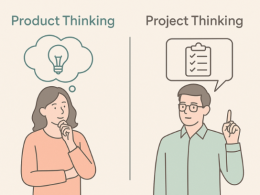In today’s fast-paced digital landscape, businesses are constantly seeking ways to outshine their competitors, captivate their target audience, and drive growth. Customer satisfaction has become the ultimate goal, and to achieve it, companies are realizing the significance of putting their customers at the heart of product development.
But, is it as simple as it sounds? Is user-centered design truly the key to achieving customer-centric product development?
We’re about to embark on an exciting journey to unravel the answers to these questions and discover why user-centered design is not just a buzzword but an essential strategy for modern businesses.
Picture this: You’ve just launched a new product or service. You believe it’s a game-changer, something that will revolutionize the market. You’ve spent months, perhaps even years, meticulously planning and developing it. But when it finally reaches the hands of your customers, it falls short of their expectations, leaving you scratching your head and wondering where you went wrong.
Sound familiar?
It’s a situation countless businesses have found themselves in, and it often stems from a lack of customer-centricity in the product development process. So, let’s dive deeper into the concept of user-centered design, explore its benefits, and find out how it can transform your product development approach into one that resonates with your customers and propels your business to new heights.
But first, let’s clarify what we mean by these two terms: user-centered design and customer-centric product development.

Understanding User-Centered Design and Customer-Centric Product Development
User-Centered Design (UCD) is a design philosophy that prioritizes the end-users’ needs, preferences, and experiences throughout the product development lifecycle. It involves continuous research, testing, and iteration to create products that align seamlessly with the users’ expectations. UCD is not just about aesthetics; it encompasses usability, functionality, and overall user satisfaction.
On the other hand, Customer-Centric Product Development is a broader strategic approach where the entire organization aligns its goals, processes, and decision-making with the primary focus on delivering exceptional value to the customer. It goes beyond the design phase and encompasses every aspect of the product’s journey, from conception to post-launch support.
The Synergy Between UCD and Customer-Centricity
Now, let’s explore why these two concepts are so closely intertwined and how they can drive your business forward.
1. Better Understanding of User Needs
User-centered design begins with thorough research to understand your target audience. It delves into their pain points, desires, and expectations. This knowledge is foundational for developing products that truly resonate with your customers, forming the basis of customer-centricity.
2. Reduced Risk
By involving users early and often in the design process, you mitigate the risk of investing time and resources in products that don’t meet market demands. This proactive approach aligns with the core principle of customer-centricity, where you aim to provide value and minimize disappointment.
3. Enhanced User Experience
UCD ensures that your products are not just functional but also enjoyable to use. A positive user experience can lead to increased customer loyalty and advocacy, which are pivotal for any customer-centric strategy.
4. Iterative Improvement
Both UCD and customer-centricity emphasize the importance of continuous improvement. Collecting feedback and data from users enables you to refine your products and services over time, ensuring they remain in sync with changing customer needs.
Success Stories: Companies Embracing UCD for Customer-Centricity
To illustrate the real-world impact of adopting user-centered design for customer-centric product development, let’s look at a few success stories:
Apple Inc.
Apple’s success story is synonymous with user-centered design. They have consistently prioritized the user experience in their product development process. Here’s how they’ve achieved this:
- Intuitive Interface: Apple products, such as the iPhone, are celebrated for their intuitive user interfaces. Their designs are carefully thought out to ensure that even a first-time user can navigate the device seamlessly. This commitment to simplicity enhances user satisfaction and loyalty.
- Sleek Design: Apple’s products are known for their aesthetic appeal and sleek design. They understand that a well-designed product not only performs well but also looks and feels good. This focus on aesthetics aligns with UCD principles, as it enhances the overall user experience.
- Ecosystem Integration: Apple has created an ecosystem where all their devices and services seamlessly integrate with each other. This ecosystem-centric approach ensures that users have a consistent and cohesive experience across their Apple devices, further enhancing customer-centricity.
Amazon
Amazon’s rise to become a global e-commerce giant can be attributed to their relentless pursuit of customer-centricity through UCD:
- Customer Feedback: Amazon places an enormous emphasis on customer feedback. They prominently feature customer reviews on product pages, providing valuable insights to potential buyers. This transparency builds trust and and empowers customers to make informed decisions.
- Personalized Recommendations: By leveraging user data and employing algorithms, Amazon offers personalized product recommendations. This not only helps customers discover new products but also keeps them engaged on the platform, fostering a customer-centric approach.
- Continuous Evolution: Amazon’s ability to adapt and evolve its offerings is a testament to UCD. They are constantly innovating and expanding their services to meet changing customer expectations, whether it’s through Prime memberships, one-click purchasing, or same-day delivery.
Airbnb
Airbnb disrupted the hospitality industry by prioritizing user needs and feedback:
- User-Generated Content: Airbnb allows hosts and guests to provide reviews and ratings. This user-generated content is a cornerstone of their platform, helping potential guests make informed choices and fostering a sense of trust within the community.
- Customization: Airbnb’s platform offers a wide range of choices for hosts and guests, allowing users to customize their experience. Whether it’s choosing between different types of accommodations or setting specific preferences, Airbnb empowers users to shape their own journeys.
- Responsive Design: Airbnb’s website and app are designed with responsiveness in mind, ensuring a seamless experience across various devices. This user-centric approach caters to the diverse needs and preferences of their global user base.
The relationship between user-centered design and customer-centric product development is symbiotic. UCD serves as the foundation on which customer-centricity thrives. By genuinely understanding your users, involving them in the design process, and iterating based on their feedback, you can create products and services that not only meet but exceed customer expectations.
So, is user-centered design the key to customer-centric product development? Absolutely! It’s the compass that guides your journey toward delivering exceptional value to your customers and securing long-term success in today’s competitive business landscape. Embrace UCD, and watch your business flourish as it places customers firmly at its core.
Ready to take your product management skills to the next level? Join Accredian’s Product Management Course today and unlock a world of opportunities.
 Pin
PinDon’t miss out on this chance to supercharge your career! Enroll now!






